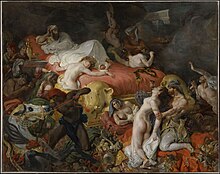The Death of Sardanapalus
The Death of Sardanapalus (La Mort de Sardanapale) is an 1827 oil painting on canvas by the French artist Eugène Delacroix, now in the Musée du Louvre, Paris.
[2] It is a work of Romanticism based on the tale of Sardanapalus, a king of Assyria, from Greek historian Diodorus Siculus's library.
The whiteness of Sardanapalus's robe, the creamy lines of the dying women's limbs, and the shimmers of gold objects throughout the scene pull the viewer's eye quickly around the painting.
Delacroix's main figural subject was Sardanapalus, a king willing to destroy all of his possessions, including people and luxurious goods, in a funerary pyre of gore and excess.
Dorothy Bussy quotes one critic of the work as calling the painting "the fanaticism of ugliness" when it appeared in the Salon in 1828.
[4] Art historian Linda Nochlin has argued that this painting scandalized the Salon because it was understood by contemporaries as a destructive sexual fantasy of Delacroix's own—a collapse of the distinction between the "Other" of Orientalism (i.e., Sardanapalus) and western man.

